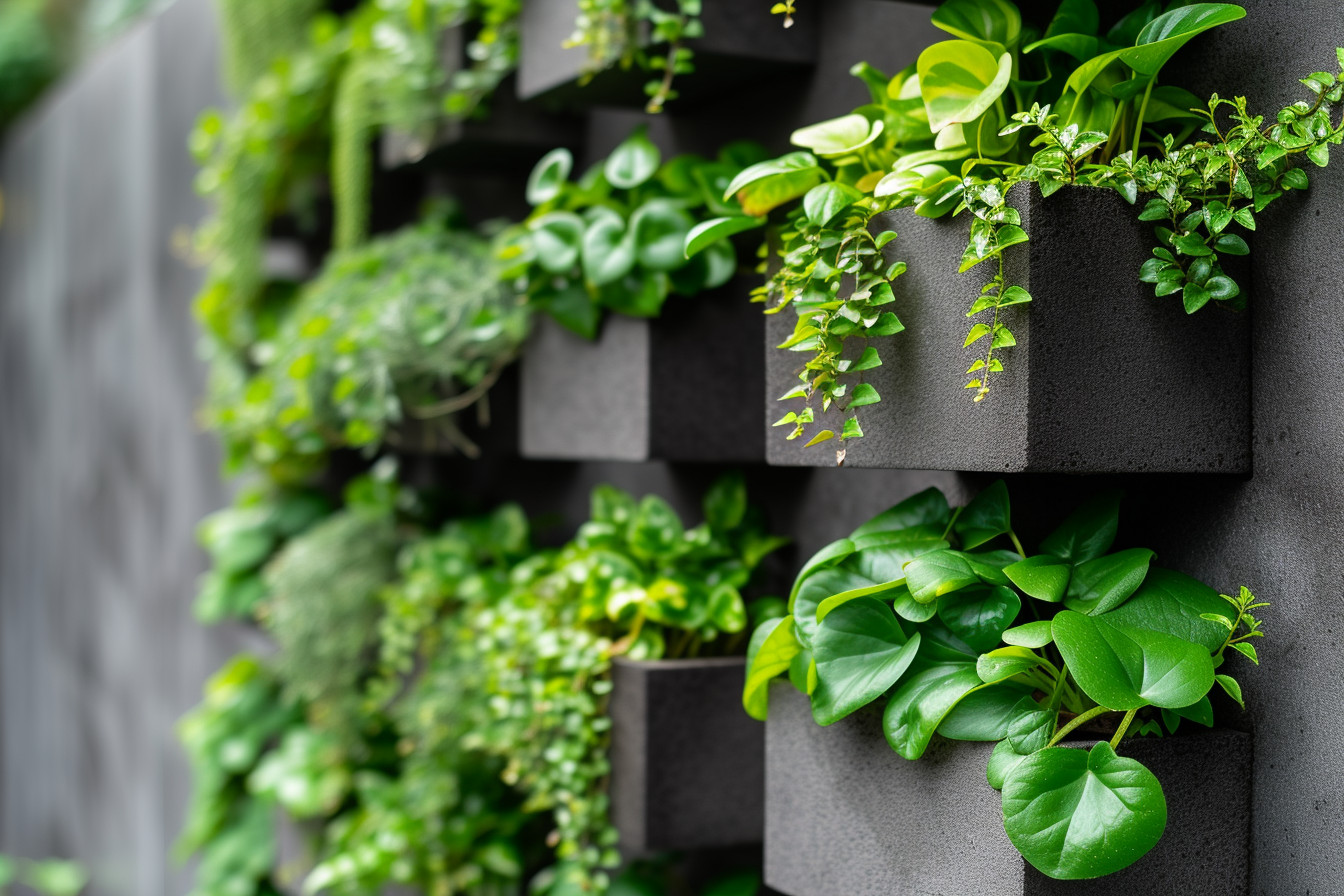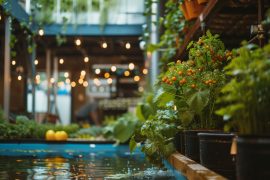DIY vertical gardening is a bit like hitting two birds with one stone. You get to enjoy the therapeutic benefits of gardening and save space while you’re at it. For those living in urban areas or just anyone looking to add a green touch without sacrificing much real estate, going vertical is your best bet.
Think about all the creative containers lying around waiting for their second life: an old shoe organizer, pallets begging for transformation, even plastic bottles can become homes for plants seeking sunlight vertically rather than sprawling across valuable ground space.
This adventure isn’t only about finding unique ways to garden upwards but also connecting deeper with nature right where you are. It’s easy enough that beginners won’t feel overwhelmed, yet it offers endless possibilities for customization, making it engaging even if your thumbs have been green for years.
What is vertical gardening?
Picture this: towering green walls, not just outside but inside your home, overflowing with vibrant foliage and fresh produce that’s both beautiful and edible. Welcome to the world of vertical gardening, a game-changer for those who love gardening but find themselves short on space. It’s like hitting Ctrl + Shift + Up Arrow in traditional horticulture; you’re taking things from horizontal to oh-so-vertical.
At its core, vertical gardening involves growing plants upward using trellises, wall-mounted containers, towers of pots, or planting systems specifically designed for such endeavors rather than spreading them out across the ground. You could be cultivating fragrant herbs right next to your kitchen window or perhaps decking up an unassuming blank wall with succulents that demand little yet offer so much in return.
The charm doesn’t end there, though! Let me sprinkle some cool stats into our garden chat:
Urban areas have seen a 67% increase in folks adopting vertical gardens because they simply make sense when square footage comes at a premium.
Another delightful nugget? These living columns can reduce surrounding air temperatures by up to 10°F thanks solely to the leafy magic known as evapotranspiration—cooling cities one leaf at a time!
Beyond pure aesthetics—and let’s admit it, modern art has nothing on meticulously arranged leaves cascading down your floor-to-ceiling indoor water feature—vertical gardens are workhorses.
Benefits of Vertical Gardening
So, you’re thinking about venturing into the world of vertical gardening? Great choice! There’s a whole bunch to love and even more to gain from setting up your little green oasis. Whether you’ve got just a cozy balcony or an expansive backyard that needs sprucing up, going vertical is both smart and stylish.
For starters, space isn’t much of an issue anymore with this approach. Traditional gardens demand plenty of horizontal real estate, which not everyone has at their disposal, especially in urban areas where every square inch counts. With vertical gardening, things like walls, balconies, railings, or any upright structure become potential spots for growing plants, herbs, vegetables—you name it!
Then there’s water conservation—something majorly significant considering our planet could use all the TLC we can give right now when it comes down to resources.
Unlike conventional methods that often lead to watering being spread out thinly across large patches of soil, requiring loads of auxiliary efforts (think sprinkler hoses constantly running), vertically arranged setups usually feature self-contained irrigation systems. These drip directly into root zones, minimizing waste and maximizing efficiency. It’s kind to the environment and wallet alike.
But wait until you hear about the aesthetic benefits. The visual appeal of adding vibrant, lush layers of flora, functionality aside, turns dull blank canvasses alive, transforming them into living art.
This also invites biodiversity since a variety of species coexist in a compact area, attracting beneficial insects. pollinators Plus, nothing beats personal satisfaction watching tiny seeds grow and flourish under care.
All told, embrace it and reap myriad rewards. While there may be challenges, there is no denying the transformative effects. physical and mental realms Let creativity soar soon, and see the concrete jungle transform. serene sanctuary, wonder, exploration, and discovery Ready, get hands dirty, journey, fill soul contentment, whisper wind, keep company, don’t forget’vertical’ new horizon, limitless possibilities await.
Planning Your Vertical Garden
Dreaming of a lush, vertical garden that transforms your space into an oasis? You’re in the right spot. Let’s dive into planning your heavenly green haven, step by step.
First off, consider what you want from your garden. Is it herbs within arm’s reach for cooking enthusiasts or cascading blooms to beautify a stark wall? Identifying this helps pinpoint which plants will make up your living tapestry. Remember, not all greens love hanging out in high places; some prefer their roots firmly planted at ground level.
Now let’s talk about location. Your choice dictates everything—from the type of containers you’ll need to plant selections tailored to sunshine and shade conditions.
Water system setup is next; think irrigation simplicity meets efficiency. It can range from sophisticated drip systems (yes, please!) integrated during installation to manual watering if there aren’t accessibility issues.
Think about how much time you’re willing to set aside. This moment of contemplation determines whether Sunday mornings are tranquil bonding sessions pitching water can lullabies bathing foliage babes rousing them. Dawn’s lessons in photosynthesis
Remember Leonardo da Vinci saying,
“Simplicity is ultimate sophistication.”
When picking out containers, creative freedom shouts loudly. Stackable units repurposed from items like old wooden crates, shoe organizers, and paint buckets unleash repetitive inventiveness.
Creative Container Ideas
Think outside the traditional gardening box and let your creativity lead the way with vertical gardening. There’s something truly magical about intertwining nature’s beauty with unique containers that reflect personal style while maximizing space. Imagine sipping morning coffee surrounded by a flourishing wall of green, all thanks to inventive container choices.
Upcycled Treasures
Who knew old wooden crates or discarded pallets could become stunning plant displays? With a bit of DIY magic, transform these items into rustic, chic vertical gardens perfect for herbs or succulents. It’s not just eco-friendly; it adds instant charisma to any corner of your home.
Shoe organizers are no longer confined to closets—they’re finding their second wind as innovative garden spaces! Hang one on a sunlit wall, fill each pocket with soil and plants, and voilà—a living tapestry before your eyes!
Let’s dive deeper:
Wine Bottles: Hollow out some used wine bottles for sleek hanging planters that catch light beautifully.
Rain gutters: Repurpose them into rows hung against walls filled with flowers, creating waves in bloom.
These ideas don’t merely offer utility but bring stories into our homes—imagine telling friends how those vibrant kitchen window herbs were once thriving in what was destined for landfill.
Speaking from experience, there is nothing quite like bending ordinary objects’ intended purposes toward nurturing life—an embodiment showing us new perspectives on looking at materials we’d usually overlook.
The joy doesn’t end at assembly though: maintaining these micro-ecosystems brings its own kind of rapture, reflecting the zen-like peace felt when caring for a wide array of greens cascading down a rain gutter turned floral cascade feels align stars themselves, lending moments of calm daily hustle.
Through every little leaf tended, birth whispers renewal and transformation right in our own hands.
For folks yearning to infuse intimate storytelling connections within craft vertically, garden mingles blend historical nuance. cultural significance, unmatched vibrancy, ready to be unleashed through a treasure trove of everyday artifacts waiting to be reborn under tender love care.
So next time you find yourself pondering over keeping odds around the house, consider the legacy they might hold transformed into a captivating centerpiece. lush verdure, beckoning a closer look at the union between human ingenuity and Mother Nature’s finest
Repurposing Everyday Items
Diving into vertical gardening opens up a world of creativity, especially when you start exploring how to repurpose everyday items for your green space. It’s all about seeing the potential in things that might otherwise end their journey at the recycling bin—or worse, the landfill.
Imagine transforming an old wooden ladder into a tiered garden stand where cascading plants breathe new life into each step. Or picture turning those empty mason jars, which once held delicious preserves or sauces, into hanging herb planters that add both flavor and freshness right outside your kitchen window.
These aren’t just hypotheticals; people are making them happen in backyards and balconies around the globe!
But think beyond ladders and jars—old bookshelves can offer ample shelving for potted plants while giving off “secret garden” vibes with every blooming season. Old drawers from discarded dressers find second lives as unique hanging containers ready to be filled with soil and seeds.
Every one of these examples serves two purposes: reducing waste by giving objects a second chance at usefulness and creating serene havens brimming with leafy friends against gravity—for anyone willing to invest some time (and very little money). What starts as eco-friendly projects morph quickly into personal retreats lined with greens—a stark reminder of nature’s magical rejuvenation powers amidst urban concrete jungles.
So before tossing out what may seem like junk, remember that it could very well become an integral piece of your next tranquil escape within arm’s reach!
Using Hanging Planters
Hanging planters can add a whimsical touch to your vertical garden, creating an enchanting environment that floats in mid-air. It’s like adding layers of green cascades that beckon calm and serenity into spaces you didn’t know could foster such tranquility.
Let’s dive right in to why hanging planters are nothing short of magical for small and large gardens alike. For starters, they’re amazing space-savers! Whether it’s cozy balconies or expansive backyards aiming for an added dimension, these dangling delights make use of the oft-overlooked vertical real estate.
Picture this: vibrant petunias spilling over sleek metal baskets or lush ferns gently swaying from macramé holders—each planter tells its own story while contributing to a more extensive tapestry made lively through varieties not typically seen together at ground level.
To get technical, but keeping it as light as morning dew, gravity assists with drainage issues prevalent in traditional gardening methods. Water trickles down naturally from one vessel to another when arranged tier-wise, making sure each gets its share without waterlogging roots—quite the clever watering system, if I might say!
And here’s where storytelling weaves its way into our leafy narrative:
Karen, who lives on the ninth-floor apartment block, transformed her balcony view completely by introducing hanging pots filled with perennials and annual blooms.
In all honesty, what makes hanging gardens so profoundly beautiful is their gentle reminder for us grounded folks about perspectives—sometimes changing angles unveil whole new worlds waiting just overhead, ready to be explored through botanical beauty hung pleasantly under sunlit skies or lit terraces beneath stars.
Building a Vertical Pallet Garden
Got an old pallet lying around? You’re sitting on a goldmine for starting your very own vertical garden! These babies are fantastic because they offer both functionality and charm without breaking the bank. Here’s how you can transform one into a lush, space-saving green spot.
First things first: safety check. Ensure your chosen pallet is stamped with “HT,” which means it was heat treated rather than chemically treated—your greens will thank you later. Next up, give that palette some good ol’ tender love by sanding down any rough edges to avoid splinters during planting or maintenance sessions.
Now onto the fun part—wrapping it all up in landscape fabric to create cozy little pockets for your plants to snuggle into. Staple that fabric securely in place against the backside and along its open edges; think of wrapping them like you’re tucking them in at night!
Fill those snug spots with soil (a lean towards looser potting mixes works wonders), then choose what gets planted where based on sunlight exposure and water needs—it’s pretty much match-making but plant edition!
So why not give this DIY project a whirl as we head further into gardening season? Not only does building such gardens strengthen our connection with nature straight from our patios or balconies, but these living art pieces also invite tranquility right outside our doorsteps while tackling limited ground space issues.







